A beautifully-restored 1972 County 4000-Four
Posted by Chris Graham on 18th January 2024
Willie Carson admires Tommy Moorhead’s beautifully-restored 1972 County 4000-Four, four-wheel-drive tractor.

This wonderful County 4000-Four has been restored by Tommy Moorhead and his son, Stephen.
What’s in a name? Why did the firm, which became known for its four-wheel-drive tractor conversions, start its life as County Commercial Cars? This famous business originated in 1929 because of a simple change in road traffic legislation that restricted light commercial vehicles to a payload of 30cwt (1.5 tons), and a top speed of 20mph, but allowed vehicles with three axles to carry three tons at 30mph.
Brothers Ernest and Percy Tapp ran a motor transport business and to take advantage of the new regulations, Ernest, the engineer in the partnership, extended the chassis rails of a Ford AA lorry and then added a third axle. Two variants of the conversion were constructed, a 6×2 with a ‘dead’ third axle, and a 6×4 with a driven third axle; a concept that set the wheels in motion as County Commercial Cars progressed into the world of increased traction for forestry, construction, and agriculture.
During the 1950s, the company developed a successful range of crawlers and four-wheel-drive tractors with equal-sized wheels, mostly based on Fordson Major skid units. These tractors evolved to include six-cylinder engines and have now become the glamorous exhibits at shows across the country, but County’s application of the four-wheel drive principle to tractors with smaller front wheels deserves closer scrutiny.
County wasn’t the first firm to develop four-wheel drive conversions that offered more versatility and manoeuvrability than their cumbersome equal-wheeled titans. Selene had produced a driven front axle kit for the Ferguson TE-20 in the mid ’50s, and Roadless had been converting Majors, Dextas, and Super Dextas since the early ’60s – all of which featured smaller front wheels and were more suited to small and medium-sized farms.
Ford’s 6X range was superseded by the 6Y ‘Ford Force’ range, that included the three-cylinder, 62hp 4000 – a tractor thought to be worth consideration for a four-wheel drive conversion.
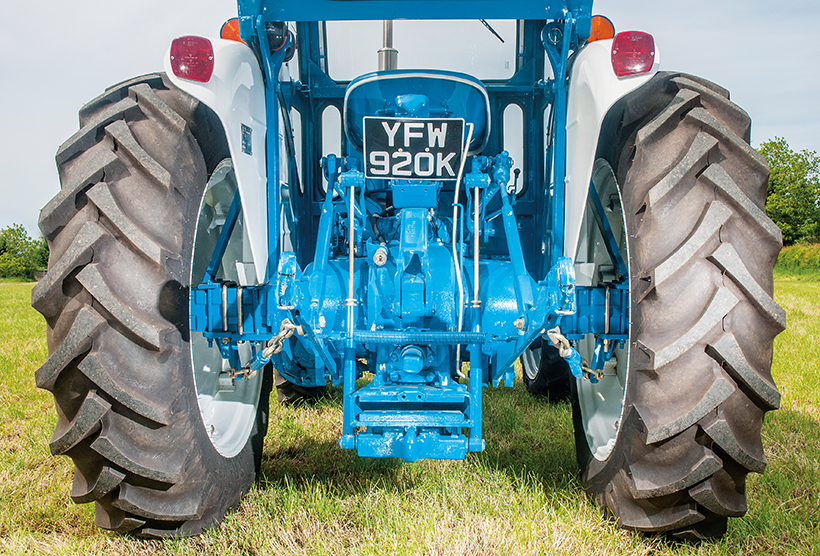
There may only be one single-acting spool valve, but there’s a pick-up hitch!
With little space inside the standard transmission housing, some creative engineering was required, but with County’s experience in problem solving, eventually all obstacles were overcome, new parts were machined, and the tractor assembled – and all within six months of the project’s inception.
New safety cab regulations were just over the horizon, so Alexander Duncan of Aberdeen was contracted to design and supply an approved cab for fitment in County’s Hampshire factory.
After ‘shake-down’, field, and safety tests, the 4000-Four was unveiled at the 1968 Smithfield Show and having proved its capabilities as a ploughing tractor in press demonstrations the following February, it was also found to be particularly suited to front-end loader work, undergoing trials with Cameron Gardner, Farmhand, and Browns.
Advertised as ‘a County tractor that everyone can afford’, it was an attractive alternative for hill farms and livestock enterprises, as well as providing added traction for light arable work. So successful was the principle of bringing four-wheel drive into a manoeuvrable, short-wheelbase, lightweight machine, that County went on to develop it for the Ford 4600, 6600, 7600, 6700, and 7700 skid units, after which Ford developed its own four-wheel drive models as a part of Series 10… but it all began with the County 4000-Four.
Troubled two
Tommy Moorhead’s introduction to the County marque came about 15 years ago when he heard of a 4000-Four that was for sale locally. “The man actually had two of them – one with no cab, and one with a front axle off a two-wheel-drive tractor. Probably the original axle had failed, and the standard 4000 axle was fitted to keep the tractor working.
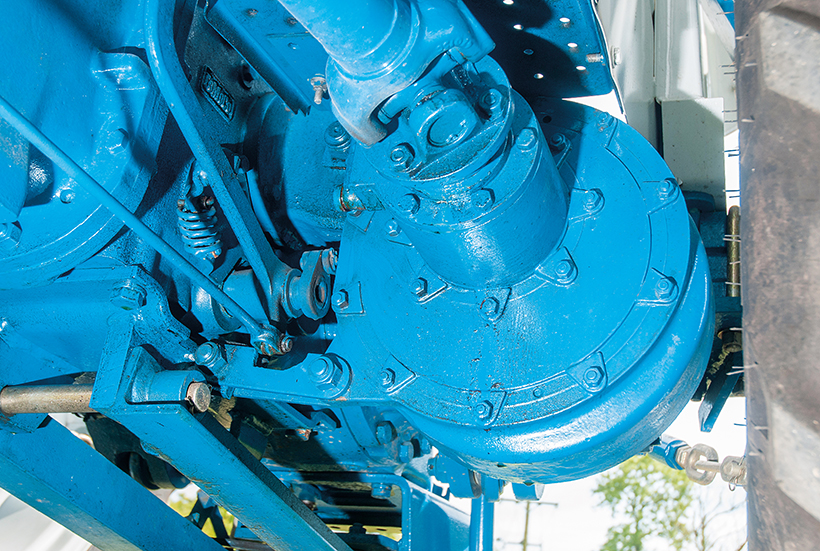
Unlike County’s unequal-sized wheel conversions, the 4000-Four utilises a single prop shaft, on the left-hand side.
“The engine was well worn and very hard to start, but it did drive, so it was used to cart firewood. When my son Stephen was building his garage, he used it to cart building materials.”
In 2015, Tommy and Stephen took the decision to start the full restoration of the County, beginning with a closer assessment of the engine, and since Stephen is a plant fitter in a quarry, his experience was going to be useful.
“I took the injector pump and the injectors to Gary Wishart, the local specialist, and after it had been serviced and refitted, the engine did start easier and run better, but it was still a long way from perfect. There was evidence at the breather pipe that the rings were worn, which all pointed towards further wear and tear, so we stripped the engine for a closer look.
“The original block was good enough to use again, so I had the bores prepared for new liners and the deck faced, just to tidy it up for the head gasket. I measured the crank journals and found that they were all still within spec, so I sent them to C&R Engines for polishing and refitted it all into the block with new shell bearings.
“The camshaft bearings were fine, but it made sense to fit a new oil pump and replace the pump drive at the same time. BPH Engineering lightly skimmed the head, and we fitted new valves into the original guides, but other than that the build was straightforward, and I finished it off with a new water pump, had the radiator re-cored, and fitted a new clutch kit.”

Two types of front axle were purportedly used throughout production of the 4000-Four.
Since the day Tommy bought the 4000-Four, he had been looking for a County front axle so that the tractor could be restored to its fully functioning, four-wheel drive glory. He found an axle, but before he had fitted it, one of the local classic tractor enthusiasts checked through a list of County tractor serial numbers and discovered that there were two different axles for the 4000-Four – one had a round casting, and the other was square in appearance and built to withstand greater loads.
A quick cross-check showed that Moorheads’ 1972 tractor should have a round axle, not Tommy’s recently acquired square axle.
Eventually, the correct assembly was found, and the restoration gained momentum once more, as Tommy explains: “We stripped the axle and found that there was a lot of water inside, but the differential gears were still in good condition, although the bearings needed to be replaced. We refitted the axle housings and replaced the outer bearings, re-shimmed the end float, and fitted new seals.
“The propshaft came with the purchase of the axle and needed new cross pins in the universal joints, but the slider was free on its splines.”
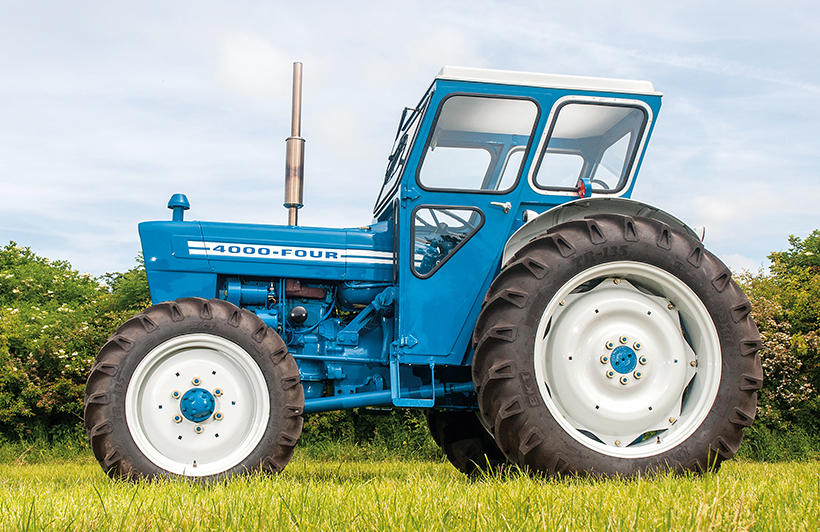
The classic silhouette of a Duncan cab!
The drop box on the 4000-Four is of a very compact design when compared to the larger tractors in the County range. It combines castings and machined parts specific to the model, with some modified components from the Ford parts list.
Costly axle
Tommy and Stephen were happy to find that most of the parts could go back into service, with only the seized transmission brake pack needing attention. Stephen continues, “The swivels were still in good condition with hardly a mark on the chrome, so they could be refitted, but there was work to do to the steering.
“The axle pivot was re-bushed, the top steering pins had new bushes fitted, and new taper bearings went into the lower pin housings, but the hardest parts to fix were the top plates on the swivel housings, which also act as the steering arms.
“The tapers for the track rod from the steering box, and for the track rod which joins the two swivels, were all worn out, so we decided to cut them off the plates and have new tapered sections made to weld back on, before putting it all back together with new track rod ends.
“There was probably more money spent on the steering than the engine! The rest of the mechanical work was fairly straightforward. The independent wet brakes needed new friction plates, and we had to replace the famous Ford rubber boots on the levers.

The tractor was originally supplied by Harris of Epworth Ltd. and retains its Lincolnshire registration mark.
“The hydraulic system was all working as it should, so all we did was drop the oil, wash out the bottom of the back end, and then give it a filter change and fresh oil.”
Tommy recalls an odd set-up relating to the rear linkage: “The lower link arms were different – one had a quick-attach end and the other didn’t, so we had to buy another quick-attach arm and then replace the springs which hold the balls in place, so that everything was tight again.”
It was now time for Tommy to turn his attention to the appearance of the tractor. “It was sandblasted, brought straight home, and given a coat of etch primer. Then I sprayed on primer and the Ford Tractor Blue topcoat. The mudguards had to be replaced, and the nose cone needed some attention, but the rest of the tinwork was generally good.
“The roof on the cab had been replaced at some stage by a sheet of tin, just welded on, so I had to find a fibreglass replacement, but the doors and the back window frame were grand. It was all resprayed, the new glass was cut locally and went in with new rubber seals.
“The original aluminium top grille was too far gone to re-use, so I had to fit a reproduction chromed grille, but the County badge is original – just prepped, painted, and polished.”
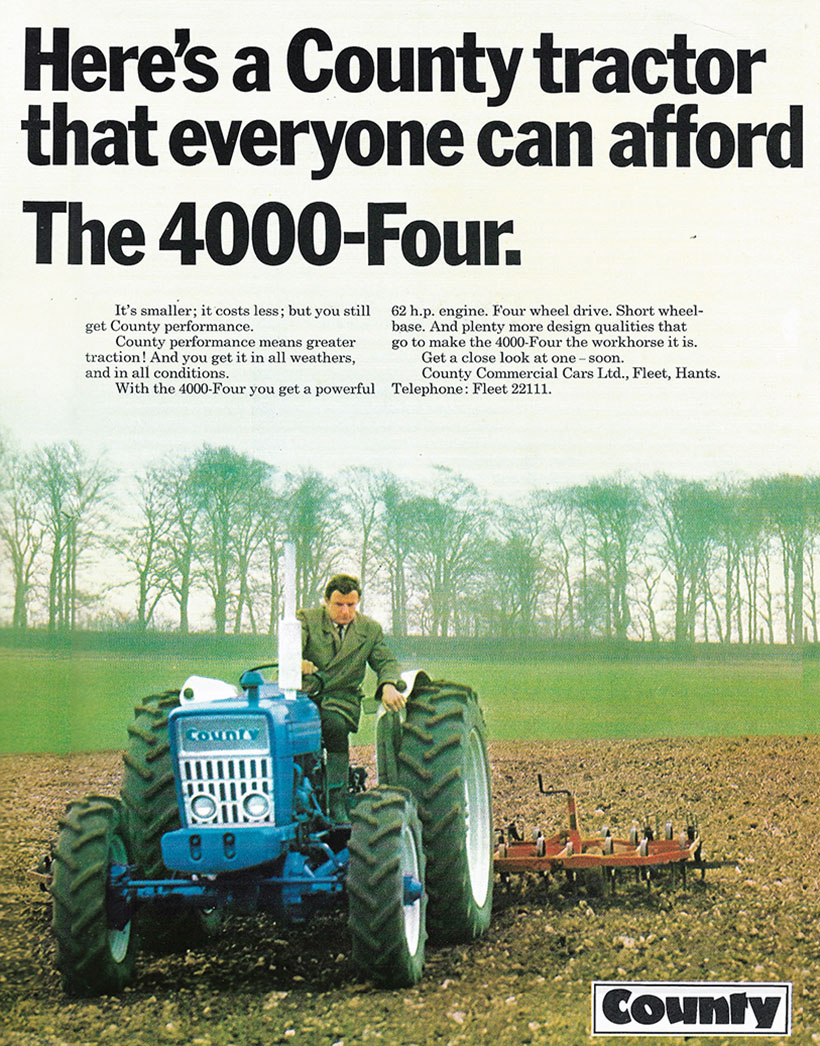
An advertisement for the 4000-Four.
The tractor was re-wired with a new loom, a new wiper motor, and new lights, and the cab finished off with new mounting blocks, door handles, a roof lining, and seat cover from Logan McMaster of Tractor Cab Specialists.
Tommy’s County 4000-Four made its first appearance at the Braid Valley Vintage Enthusiasts’ celebration of 100 years of Fordson and Ford tractors, where it perfectly exhibited the intertwined histories of County Commercial Cars and the Ford tractor empire.
Ford, like its competitors of that era, went on to develop its own four-wheel drive tractors with unequal-sized wheels, quickly making Ernest and Percy Tapp a victim of their own genius, but with an ever-passionate band of supporters, the name of County will be long remembered.
* Since Tommy and Stephen have a square-profile front axle for a County 4000-Four that is surplus to their requirements, they are willing to sell it to another enthusiast, as it could lead to the completion of another classic County.
Any interested parties should contact the editor in the first instance, via e-mail (tm.ed@kelsey.co.uk), and details will be passed on to Tommy Moorhead.
This feature comes from a recent issue of Tractor & Machinery, and you can get a money-saving subscription to this magazine simply by clicking HERE
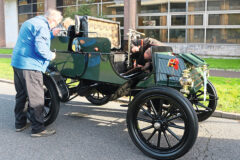
Previous Post
How to complete the London to Brighton Veteran Car Run

Next Post
What’s to be found in the excellent Dover Transport Museum?



